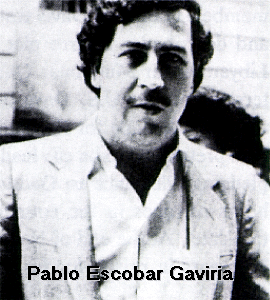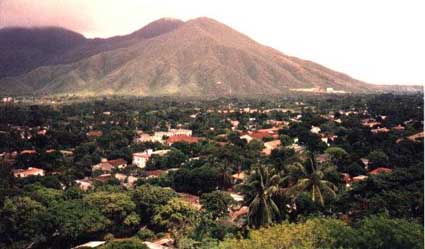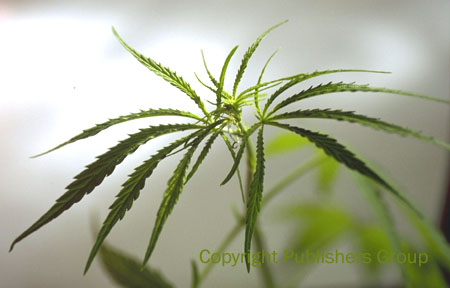| Home |
| History and uses of the Coca leaf |
| Other uses of coca, including the production of cocaine |
| The Drug Trade |
| Drug Wars |
| Bibliography |
| Andean History |
Latin American Drug Trade News Report

Okay, so you want the current scoop on the
drug trade, well, this is about as good as it gets unless you want to go
door to door asking drug lords to fill out your survey. Yeah, thatís right,
I would just stay here too. God only know why you want to know this stuff,
maybe youíre a wanna-be Keith Gordan, but sit back and relax . . . here
comes your LATIN AMERICA DRUG TRADE NEWS REPORT!
The main source areas of coca and the
opium poppy have plateaued in their production levels. This is most likely
due to either bad weather and crop diseases, so make sure your little guys
get plenty of water and light, and bag Ďem if your plants on the perimeter
start to look sick. This drop in production is not common throughout the
coca belt; with increased efficiency growers in Colombia and Bolivia are
improving their overall hectare yield. It would appear that the cultivation
of "the wonderful plants" has spread to some areas that are new to the
game. We have reports that the former-Soviet states in central Asia have
begun cultivation (Stares, 3).
Speaking of new crops, we have news
that opium fields have sprung up in Peru, while our Colombian boys are
now a source of heroin. For those just coming up in the trade this is an
important lesson, diversify your portfolio. Often drugs will take a hit
in sales or youíll have a bad crop, Pat in Saint Louis knows what Iím talking
about, and if your not diversified you could go under, maybe way under,
like six feet.
The Anglo growers have some news from
the lab that may jeopardize the value of the Acapulco Gold you have in
inventory. Theyíve been increasing the THC, THC or tetrahydrocannabinol
is the stuff that cotes the nerve cells in the brain giving pot heads the
delayed reaction speed when they are high, in the chiva grown in North
American and Europe. These are big markets so beef up your importation
crew and get your payoffs out there while you can.
Okay, hereís an inside tip. Are you having
trouble making your sales quotas? Is your trafficking department constantly
screwing up? Move to the new Asian markets. All the former-Soviet states
are great place to start. These States, and China, are the hotbed for growth
in terms of new users. Importation is not nearly the problem it is in the
West, but I do recommend that you take your goods through the western border
of China, it is significantly less patrolled than the east, but thatís
were all the users are so you better figure out how to get it there. You
might want to land of the coast and ship it in or you could ship it the
whole way, either way if your boat gets popped a payoff will rarely get
you buy.
SPECIAL INTRODUCTORY SECTION FOR THOSE NEW TO THE "TRADE"
Letís cover some of the basics for those
who might be new to the game. By the way, if you are staring out, welcome
to an industry that generates $122 billion in the United States and Europe
alone. Worldwide, on illicit psychoactive substances we rake in upwards
of $300 billion. You can get your piece of the pie, but it better not be
my piece (Stares, 1-2)

Bolivia, is good friend to those in
the chiva market, which means marijuana. It produced between 46,000 to
67,000 metric tons in 1987, and remember that production is up. Bolivia
is one of the poorest nations in the Western Hemisphere. Only Haiti has
a poverty level that is lower on the whole, if youíve ever been to Haiti
you know this is real bad. Donít fret humanitarians, by the way if any
shed a tear at the poor Bolivia stuff, shoot Ďem. He would have been a
weak link and this isnít a business for weak links (MacDonald, 51).
There are a couple reasons why Bolivia
is one of our Promised Lands of the drug trade. Yes this is a history lesson,
but youíve got a lot to learn so put down the pipe and get your mind right.
Remember that there have been 200 coups since the Bolivians became independent
of the Spanish in 1821. The government always has a hard time solidify
power in the periphery. That is the rural countryside, where The Shining
Path was busting it up in Peru until í92. Power was concentrated around
La Paz, with regional patrons always holding power in the hinterland.
Although the M.N.R. Revolution would
have appeared to create a situation where rich drug lords would be stomped
by peasants, the opposite is actually true. After the revolution geographical
areas were centers of fragmented power and were only weakly held together
by the national government. The programs designed at modernizing the countryside,
during the late 1950ís and early 1960ís, and helping the campesinos actually
just strengthened the existing powers in agribusiness. The increased flow
of goods heightened the demand for cocaine in the 1960ís (MacDonald, 52-53).
The real boom to the cocaine industry came
on July 17th, 1980. Basically a bunch of drug lords came to power, I'll
tell you the story just hold on a bit. What is of interest to us would-be
drug lords is the personal history of Roberto Suarez Gomez. This guy had
money from day one, he was a latifundista owner and a cattle farmer. In
the 80's he went into the drug trade. He started growing coca, bought a
couple of planes, and PAY ATTENTION ROOKIES, he got a class-A act to cover
his security. An ex-Nazi, Klaus Barbie, headed the "Fiances of Death" and
SS-like group of bodyguards and hired killers. Gomez calls together a meeting
of all the top drug lords in Bolivia, of which he is the alpha male, and
bribed
the military officials to stage a coup. The coup was successful
and President Carter got all upset. Apparently the coup violated a policy
of human rights and antinarcotics (MacDonald, 55-58)
Bolivia has the weakest government in all
of Latin America and its climate is heaven for growing coca. Peru and Bolivia
have passed Columbia as the major producers of coca. What remains, as the
crown jewel in the Bolivian drug crown is the weak central government.
It is speculated that Bolivia is the only nation where the drug Mafia could
take over the government. If you going to start up in Latin America, Bolivia
is the place to be, but be aware that this the NFL of drug markets. A local
operation in one of the growth states might be a better choice.
DRUG TRADE BASICS
The sisters: Marijuana
and Heroin
These ladies will form the foundation upon
which your empire rests. Marijuana is mostly produced in Mexico, Columbia,
spots in the Caribbean, I think you know where I'm talking about, and in
basements across America. The heroin of Latin America comes mostly from
Mexico. Although these drugs are not as glamorous as their cousin, cocaine,
they have a steady group of consumers. Cocaine use is spreading though,
at the cost heroin and marijuana use, so once again remember to diversify
(MacDonald, 19).
 Heroin
is an odorless powder, Ha! drug dogs, that is derived from morphine. The
technical name is diamorphine hydrochloride. Here's how you get the goods.
You take an opium poppy after the petals have fallen off and you cut a
hole in it. You take out this goo called the gum, which then has to be
treated to take out the morphine base. You dump the base in to acetic anhydirde
and get diacetyl morphine (the heroin base). It will take you ten pounds
of opium poppies to make a pound of heroin. This means you need fields
of the stuff to have a good harvest. The heroin trade is labor intensive
as you might have gathered. Impoverished tribal peoples in the highlands
will happy to get your business going though (MacDonald 20).
Heroin
is an odorless powder, Ha! drug dogs, that is derived from morphine. The
technical name is diamorphine hydrochloride. Here's how you get the goods.
You take an opium poppy after the petals have fallen off and you cut a
hole in it. You take out this goo called the gum, which then has to be
treated to take out the morphine base. You dump the base in to acetic anhydirde
and get diacetyl morphine (the heroin base). It will take you ten pounds
of opium poppies to make a pound of heroin. This means you need fields
of the stuff to have a good harvest. The heroin trade is labor intensive
as you might have gathered. Impoverished tribal peoples in the highlands
will happy to get your business going though (MacDonald 20).
 Define
marijuana: "the dried leaves and flowering tops of the pistillate hemp
plant". Chiva can be sold throughout the world, but it is a hard product
to move in large amounts. It has been consumed in China for over two thousand
years to treat hypertension and glaucoma. Marijuana first came to the West
in the early 1800's, but it already is the second largest cash crop of
the United States. Production has dropped in places like Columbia because
the cost to possible reward ration no longer makes it as appealing a choice
for cultivation. You could start you own farm here in the States, or you
could purchase it from a Caribbean group. Remember when dealing with the
chiva in the Caribbean to call it ganja (MacDonald, 21)
Define
marijuana: "the dried leaves and flowering tops of the pistillate hemp
plant". Chiva can be sold throughout the world, but it is a hard product
to move in large amounts. It has been consumed in China for over two thousand
years to treat hypertension and glaucoma. Marijuana first came to the West
in the early 1800's, but it already is the second largest cash crop of
the United States. Production has dropped in places like Columbia because
the cost to possible reward ration no longer makes it as appealing a choice
for cultivation. You could start you own farm here in the States, or you
could purchase it from a Caribbean group. Remember when dealing with the
chiva in the Caribbean to call it ganja (MacDonald, 21)